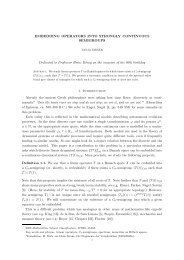Security analysis of Dutch smart metering systems - Multiple Choices
Security analysis of Dutch smart metering systems - Multiple Choices
Security analysis of Dutch smart metering systems - Multiple Choices
Create successful ePaper yourself
Turn your PDF publications into a flip-book with our unique Google optimized e-Paper software.
3.2 NTA 3 THEORETICAL ANALYSIS<br />
it impossible for the utility company to communicate with the meter. The consumer could also<br />
try to influence their usage information through the local configuration options <strong>of</strong> the meter.<br />
3.1.3 Availability<br />
From a customer perspective availability in <strong>smart</strong> <strong>metering</strong> <strong>systems</strong> means the availability <strong>of</strong><br />
electricity, water and gas itself in the first place. For a grid operator the availability <strong>of</strong> meter data<br />
from the <strong>smart</strong> <strong>metering</strong> system would be a second important asset.<br />
Before <strong>smart</strong> <strong>metering</strong> was introduced, electricity, water or gas would usually always be available<br />
unless there are problems somewhere on the grid or in case the supplier physically disconnected<br />
the supply to a customer. Smart meters enable suppliers to remotely switch <strong>of</strong>f customers in case<br />
<strong>of</strong> an emergency or in case customers have not paid their invoices or are committing fraud. This<br />
could mean that a customer can be accidentally switched <strong>of</strong>f, that a disgruntled employee switches<br />
<strong>of</strong>f customers or that this feature could be used in a “terrorist” attack on the power grid. In case a<br />
customer can interrupt the communication <strong>of</strong> the <strong>smart</strong> meter the supplier can’t receive <strong>metering</strong><br />
data and would not be able to disconnect the power supply remotely.<br />
By cutting <strong>of</strong>f lots <strong>of</strong> customers the available power load in the distribution network could become<br />
too high, and could cause a cascading effect through the distribution network which could in turn<br />
lead to a large blackout. This also works the other way around, by switching a large amount <strong>of</strong><br />
customers back on at the same time demand could get to high in certain points <strong>of</strong> the distribution<br />
network, which could also lead to a blackout [6, 52].<br />
3.2 NTA<br />
In previous sections the importance <strong>of</strong> security in <strong>smart</strong> <strong>metering</strong> <strong>systems</strong> has been explained. Next<br />
the various security aspects based on the ports as mentioned in the <strong>smart</strong> <strong>metering</strong> introduction<br />
will be analyzed. This port based view will provide a guidance to cover all aspects <strong>of</strong> the system<br />
where security comes in.<br />
3.2.1 Port P0<br />
Port P0 provides local administrative access to service engineers during installation or maintenance<br />
<strong>of</strong> <strong>smart</strong> <strong>metering</strong> <strong>systems</strong>. Households have physical access to their <strong>metering</strong> system, and therefore<br />
could try to connect to the <strong>metering</strong> system using the right equipment to interface with the P0<br />
port. Depending on the configuration options that are available through P0, this could lead<br />
to a security breach where meter data or tariff settings can be altered, which could affect data<br />
integrity. Meter data availability will be affected when communication settings <strong>of</strong> other connected<br />
ports could be modified.<br />
A second implementation <strong>of</strong> port P0 could be a set <strong>of</strong> configuration buttons on the meter itself<br />
combined with an optional display that allows an engineer to readout or modify meter settings. In<br />
case poor protective measures such as a secret key combination are being used to access these administrative<br />
features, this could lead to simple to perform attacks that don’t require any additional<br />
hardware.<br />
As mentioned in the NTA introduction, port P0 is not a part <strong>of</strong> the NTA specification, which<br />
means that there are no legal minimum security requirements available. Because an insecure<br />
implementation <strong>of</strong> port P0 could lead to security breaches on other ports and data integrity, port<br />
P0 should really be part <strong>of</strong> the NTA specification and should have a defined minimum security<br />
level. An overview <strong>of</strong> the possible P0 security risks are displayed in table 1.<br />
14

















